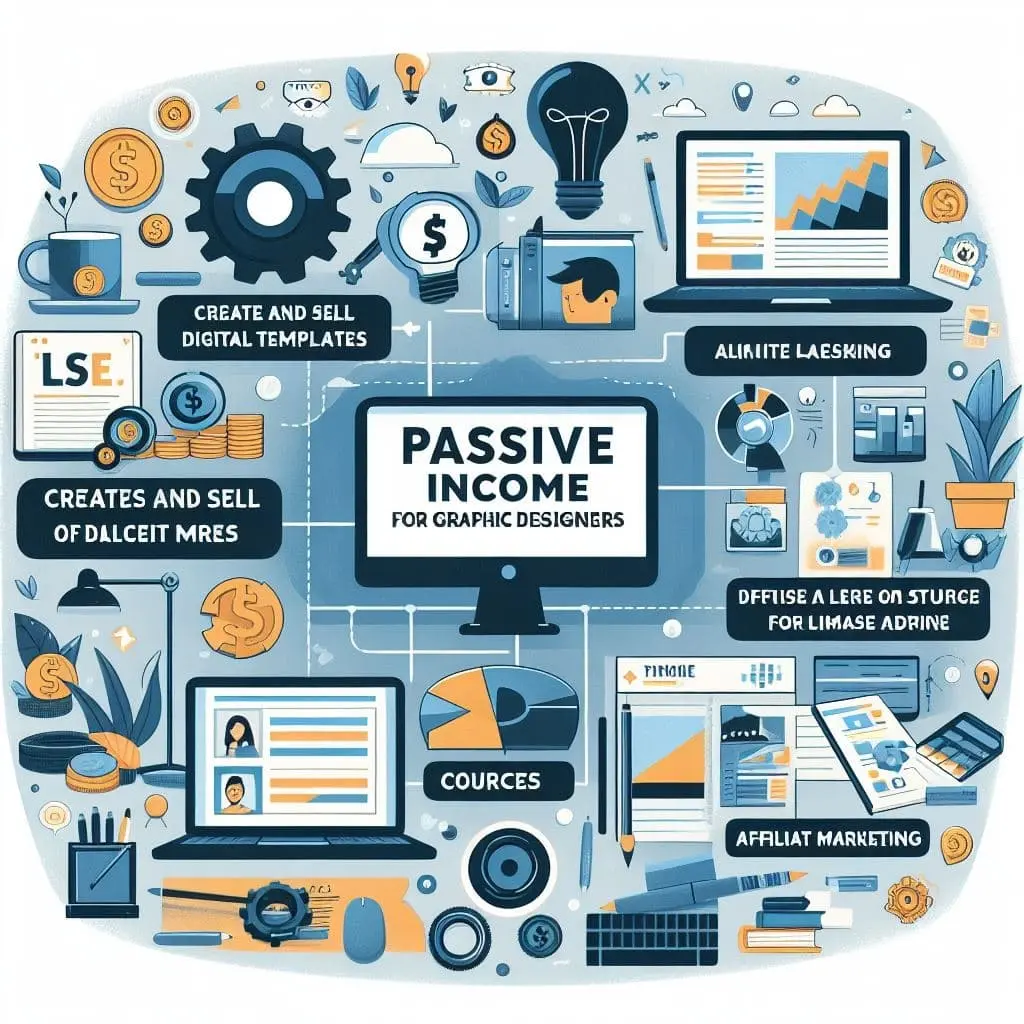Do graphic design skills pay the bills? Absolutely! But what if your designs could keep earning you money even while you sleep? Passive income for graphic designers turns your creativity into recurring income, giving you more freedom and flexibility. Let’s dive into how to leverage your talent for financial gain, beyond just hourly projects.
What Is Passive Income?
Passive income refers to money you earn with minimal ongoing effort to maintain it. It’s the opposite of active income, which you get from working a job or freelancing where you trade your time for money.
Think of it like planting seeds. You put in the work upfront (planting), but then over time, you reap the rewards (harvest) without having to constantly replant.
Here are some key characteristics of passive income:
- Requires initial investment: There’s usually some upfront work or money needed to set things up.
- Low ongoing effort: Once established, it shouldn’t require a lot of your time or daily work to keep it generating income.
- Recurring income: Ideally, it provides a steady stream of income over time.
Passive income can be a great way for graphic designers to supplement their income or even create a whole new revenue stream.
Source of Passive income for graphic designers:
1. Digital Products: This is a broad category encompassing various reusable design assets:
- Templates: Create pre-made layouts for presentations, social media posts, websites, and printable materials.
- Stock Assets: Design vector illustrations, icons, and other digital elements for others to use in their projects.
- Fonts: Develop and sell unique typefaces for designers and creative professionals.
2. Print-on-Demand Merchandise: Design t-shirts, mugs, phone cases, etc., and partner with Printful or Redbubble to handle printing and fulfillment, earning a commission on each sale. Educational Resources: Share your knowledge and expertise by creating:
- E-books: Compile your design tips, tricks, or a specific design skill into an e-book.
- Online Courses: Develop video tutorials or interactive courses teaching design principles and software.
3. Membership Sites: Offer exclusive design resources like brushes, templates, or ongoing design tutorials to paying subscribers through Patreon or Substack. Stock Photography & Illustrations: If your style extends beyond graphic design, consider selling photos or illustrations on platforms like Shutterstock or Adobe Stock.

Top 5 Strategies of Passive Income for Graphic Designers
1. Sell Design Templates:
- This is a classic strategy.
- Craft high-quality, reusable templates for presentations, social media posts, websites, or printables.
- Sell them on marketplaces like Etsy, Creative Market, or even your website.
2. Design Print-on-Demand Merchandise:
- Unleash your creativity on physical products!
- Design t-shirts, mugs, phone cases, etc., and partner with Printful or Redbubble.
- They handle printing, fulfillment, and customer service, while you earn a commission on each sale.
3. Become a Stock Asset Guru:
- Turn your design elements into valuable resources for others.
- Create and sell vector illustrations, icons, patterns, or even UI Kits on platforms like Shutterstock or Adobe Stock.
- These assets can be used by web designers, app developers, and other creatives, generating ongoing income.
4. Share Your Expertise – Build Online Courses:
- Package your design knowledge into educational resources.
- Develop video tutorials or interactive courses teaching design principles, software usage, or specific design skills.
- Sell them on platforms like Udemy, Skillshare, or even your website.
5. Create a Premium Design Membership:
- Offer exclusive content and ongoing value to dedicated subscribers.
- This could include unique design resources like brushes, templates, mockups, or access to private design tutorials and feedback sessions.
- Platforms like Patreon or Substack can facilitate memberships, allowing you to build a loyal community while earning recurring income.

Top Websites of Passive Income for Graphic Designers:
- Creative Market: A popular marketplace for designers to sell a variety of digital products including design templates, fonts, icons, illustrations, and more.
- Etsy: While traditionally known for crafts, Etsy has become a great platform for graphic designers to sell downloadable digital products like printables, templates, and social media graphics.
- Shutterstock: A well-known stock photo website, Shutterstock also allows designers to sell illustrations, icons, and vector graphics.
- Adobe Stock: Another major stock asset marketplace, Adobe Stock offers designers the opportunity to sell a wide range of digital assets including vector graphics, illustrations, photos, and more.
- Skillshare: An online learning platform where designers can create and sell online courses teaching design skills, software, and creative techniques.
- Udemy: Another popular online learning platform, Udemy allows designers to create and sell video courses on a wide range of design topics.
- Printful: A print-on-demand service that allows designers to upload their designs onto t-shirts, mugs, phone cases, and other products. Printful handles the printing, fulfillment, and shipping, while the designer earns a commission on each sale.
- Redbubble: Similar to Printful, Redbubble is another print-on-demand service that allows designers to sell their designs on a variety of products.
- Patreon: A membership platform where designers can offer exclusive content and benefits to paying subscribers. This could include early access to new designs, tutorials, discounts, or even personalized design services.
- Substack: A subscription-based newsletter platform that allows designers to create and sell email newsletters with exclusive content, tutorials, and insights.
